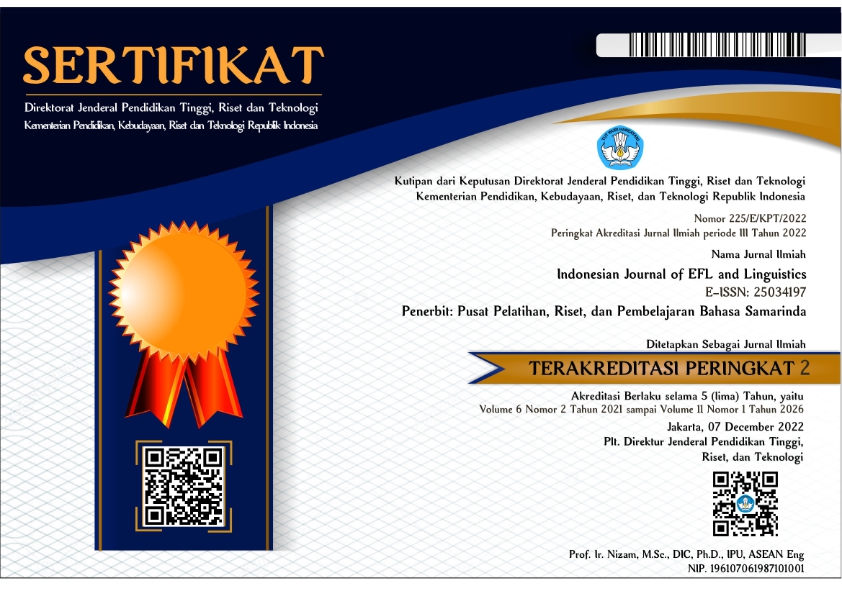Rhetorical Structures of English-Major Undergraduate Thesis Introduction Chapters
Keywords:
Introduction, Swales’ CARS, Undergraduate Thesis
Abstract
Undergraduate students are required to write a thesis to obtain a degree. One of the most important chapters in the thesis is introduction. Introduction section plays an important role because it describes what the research is all about. To write an introduction chapter, Swales (1990) proposed Create-a-Research-Space (CARS) model, which include three moves, namely establishing a territory, establishing a niche, and occupying the niche. Every move consists of several steps. This study aims to analyze Swales’ CARS model in the introduction chapters of undergraduate theses written by English major students. Furthermore, the lexical and syntactical signals in each move and step are investigated. This research employed discourse analysis, which focuses on how texts are structured. The researchers analyzed 18 introduction chapters of undergraduate theses written by the English major students of Sanata Dharma University who graduated in 2017. In analyzing the corpus, the researcher used top-down analysis. The results showed that Move 1, Establishing a territory, appeared in the undergraduate theses. However, many of the students did not review the previous research. Move 2, Establishing a niche, was presented in three theses. In this stage, many of the students did not fill in the gap about the previous research. Move 3, Occupying the niche, was frequently used by the students. In this phase, the students outlined the purpose of their research. This study also found that the lexical and syntactical signals used in the theses were quite different from Swales’ CARS model.References
Abdullah, S. (2016). An analysis of cross-discipline research article introduction structures through a modified create a-research-space (CARS) model. EFL Journal 1(1). 1-16.
Bailey, S. (2011). Academic writing: A handbook for international students (3rd ed.). New York: Routledge.
Biber, D., Connor, U., & Upton, T. A. (2007). Discourse on the move: Using corpus analysis to describe discourse structure. Amsterdam: John Benjamins B.V..
Evans, D., Gruba, P., & Zobel, J. (2014). How to write a better thesis (3rd ed.). New York: Springer International Publishing Switzerland. doi: 10.1007/978-3-319-04286-2
Fudhla, N., Rozimela, Y., & Ningsih, K. (2014). An analysis of students' research proposal introduction based on CARS model at STAIN Sjech M. Djamil Djambek Bukittinggi. Journal English Language Teaching (ELT), 2, 66-77.
Irawati, L., Saukah, A., & Suharmanto. (2018). Indonesian authors writing their discussion sections both in English and Indonesian research articles. Cakrawala Pendidikan, 37(3), 447-456.
Lewin, B. A., & Young, L. (2001). Expository discourse: A genre-based approach to social science research texts. London: Continuum.
Lipson, C. (2005). How to write a BA thesis: A practical guide from your first ideas to your finished paper. Chicago: The University of Chicago Press.
Madrunio, M. R. (2012). Move sequences in graduate research paper introductions and conclusions. i-manager's Journal on English Language Teaching, 2(1), 1-14.
Noorzan, M. N. & Page, G. M. (2012). Writing your thesis. Kuala Lumpur: Pearson Malaysia.
Schiffrin, D., Tannen, D., & Hamilton, H. (Eds.). (2001). The handbook of discourse analysis. Oxford: Blackwell Publishers.
Stephen, B. (2011). Academic writing: A handbook for international students. New York: Routlage.
Swales, J. M. (1990). Genre analysis. Cambridge: Cambridge University Press.
Swales, J. M. (2004). Research genres: Explorations and applications. Cambridge: Cambridge University Press.
Swales, J. M., & Feak, C. B. (1994). Academic writing for graduate students. Ann Arbor, MI: The University of Michigan Press.
Swales, J. M., & Feak, C. B. (2012). Academic writing for graduate students: Essential tasks and skills (3rd ed.). Ann Arbor, MI: The University of Michigan Press.
Upton, T. A. (2009). An approach to corpus-based discourse analysis: The move analysis as example. Discourse Studies, 11 (5), 585-605. doi:10.1177/1461445609341006
Bailey, S. (2011). Academic writing: A handbook for international students (3rd ed.). New York: Routledge.
Biber, D., Connor, U., & Upton, T. A. (2007). Discourse on the move: Using corpus analysis to describe discourse structure. Amsterdam: John Benjamins B.V..
Evans, D., Gruba, P., & Zobel, J. (2014). How to write a better thesis (3rd ed.). New York: Springer International Publishing Switzerland. doi: 10.1007/978-3-319-04286-2
Fudhla, N., Rozimela, Y., & Ningsih, K. (2014). An analysis of students' research proposal introduction based on CARS model at STAIN Sjech M. Djamil Djambek Bukittinggi. Journal English Language Teaching (ELT), 2, 66-77.
Irawati, L., Saukah, A., & Suharmanto. (2018). Indonesian authors writing their discussion sections both in English and Indonesian research articles. Cakrawala Pendidikan, 37(3), 447-456.
Lewin, B. A., & Young, L. (2001). Expository discourse: A genre-based approach to social science research texts. London: Continuum.
Lipson, C. (2005). How to write a BA thesis: A practical guide from your first ideas to your finished paper. Chicago: The University of Chicago Press.
Madrunio, M. R. (2012). Move sequences in graduate research paper introductions and conclusions. i-manager's Journal on English Language Teaching, 2(1), 1-14.
Noorzan, M. N. & Page, G. M. (2012). Writing your thesis. Kuala Lumpur: Pearson Malaysia.
Schiffrin, D., Tannen, D., & Hamilton, H. (Eds.). (2001). The handbook of discourse analysis. Oxford: Blackwell Publishers.
Stephen, B. (2011). Academic writing: A handbook for international students. New York: Routlage.
Swales, J. M. (1990). Genre analysis. Cambridge: Cambridge University Press.
Swales, J. M. (2004). Research genres: Explorations and applications. Cambridge: Cambridge University Press.
Swales, J. M., & Feak, C. B. (1994). Academic writing for graduate students. Ann Arbor, MI: The University of Michigan Press.
Swales, J. M., & Feak, C. B. (2012). Academic writing for graduate students: Essential tasks and skills (3rd ed.). Ann Arbor, MI: The University of Michigan Press.
Upton, T. A. (2009). An approach to corpus-based discourse analysis: The move analysis as example. Discourse Studies, 11 (5), 585-605. doi:10.1177/1461445609341006
Published
2019-11-15
How to Cite
Indrian, R., & Ardi, P. (2019). Rhetorical Structures of English-Major Undergraduate Thesis Introduction Chapters. Indonesian Journal of EFL and Linguistics, 4(2), 195-214. https://doi.org/10.21462/ijefl.v4i2.166
Section
Articles




